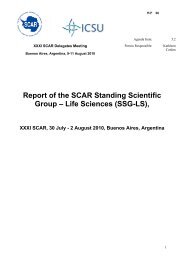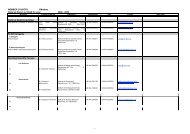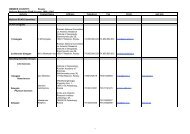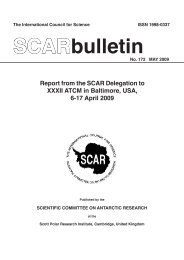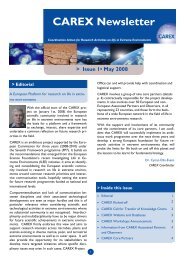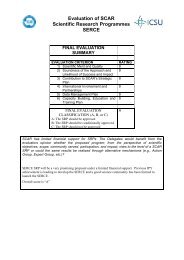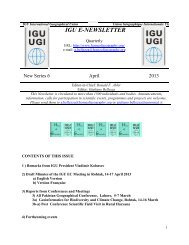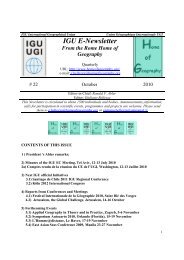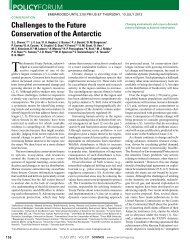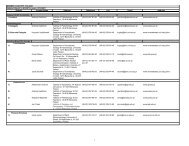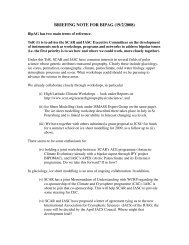SCAR Strategic Plan - Scientific Committee on Antarctic Research
SCAR Strategic Plan - Scientific Committee on Antarctic Research
SCAR Strategic Plan - Scientific Committee on Antarctic Research
Create successful ePaper yourself
Turn your PDF publications into a flip-book with our unique Google optimized e-Paper software.
<str<strong>on</strong>g>SCAR</str<strong>on</strong>g> STRATEGIC PLAN 2004–2010<br />
<strong>Antarctic</strong> scientific research, depends in large degree <strong>on</strong><br />
its overall financial capacity. <str<strong>on</strong>g>SCAR</str<strong>on</strong>g>ʼs core funding comes<br />
from Membership c<strong>on</strong>tributi<strong>on</strong>s (Annex 2). At present<br />
these are assessed <strong>on</strong> the basis of 5 categories with the<br />
following scale for c<strong>on</strong>tributi<strong>on</strong>s in 2005:<br />
Table 1. <str<strong>on</strong>g>SCAR</str<strong>on</strong>g> C<strong>on</strong>tributi<strong>on</strong>s 2005<br />
The annual income raised by Membersʼ c<strong>on</strong>tributi<strong>on</strong>s<br />
was $322,000 in 2003. <str<strong>on</strong>g>SCAR</str<strong>on</strong>g>ʼs income has stayed at that<br />
level since 1995, when income rose by about 25% due<br />
to introducti<strong>on</strong> of a new c<strong>on</strong>tributi<strong>on</strong> category, and an<br />
increase in the number of Members.<br />
From the start of 1995 <str<strong>on</strong>g>SCAR</str<strong>on</strong>g> has planned to spend<br />
50% of its income <strong>on</strong> science coordinati<strong>on</strong> and 50% <strong>on</strong><br />
administrati<strong>on</strong> of its activities. Most of the administrati<strong>on</strong><br />
costs have been in salaries to maintain the Secretariat. The<br />
amount budgeted for science averaged $167,000 per year<br />
from 1995 to 2003.<br />
During <str<strong>on</strong>g>SCAR</str<strong>on</strong>g>ʼs history, underspends of various kinds<br />
from time to time c<strong>on</strong>tributed to the development of a cash<br />
reserve that reached $382,000 at the end of 2003.<br />
9.2 The financial strategy<br />
The financial strategy for the future entails the<br />
following key elements:<br />
i. To raise the level of c<strong>on</strong>tributi<strong>on</strong>s;<br />
ii. To maintain as far as possible an even<br />
balance between expenditure <strong>on</strong> science and<br />
administrati<strong>on</strong>;<br />
iii. To maintain a cash reserve of around $100,000,<br />
so as to ensure that salaries can be paid at the<br />
beginning of each year;<br />
iv. To obtain targeted funds from appropriate external<br />
funding sources to support selected activities<br />
within the <str<strong>on</strong>g>SCAR</str<strong>on</strong>g> programme, and, if possible, to<br />
double by that means the budget obtained from<br />
c<strong>on</strong>tributi<strong>on</strong>s;<br />
v. To levy a small overhead charge <strong>on</strong> all external<br />
funds handled by <str<strong>on</strong>g>SCAR</str<strong>on</strong>g>, to reflect the cost of<br />
administering grants and to provide an additi<strong>on</strong>al<br />
source of financial flexibility;<br />
vi. To encourage Members to provide additi<strong>on</strong>al<br />
voluntary c<strong>on</strong>tributi<strong>on</strong>s to provide extra flexibility<br />
and support for science;<br />
vii. To attract new Members (e.g. from am<strong>on</strong>g the<br />
parties to the <strong>Antarctic</strong> Treaty);<br />
viii. To save where possible <strong>on</strong> administrative costs.<br />
The rise in c<strong>on</strong>tributi<strong>on</strong>s is called for to meet new<br />
requirements for <str<strong>on</strong>g>SCAR</str<strong>on</strong>g> funds that have originated in part<br />
from the <str<strong>on</strong>g>SCAR</str<strong>on</strong>g>ʼs reorganisati<strong>on</strong> and that are causing the<br />
cash reserve to be depleted. First of these requirements<br />
is the restructuring of the <str<strong>on</strong>g>SCAR</str<strong>on</strong>g> Secretariat described in<br />
secti<strong>on</strong> 8.2 (above) and intended to create a more proactive<br />
Secretariat to ensure c<strong>on</strong>tinuity in <str<strong>on</strong>g>SCAR</str<strong>on</strong>g> operati<strong>on</strong>s in the<br />
two-year hiatus between <str<strong>on</strong>g>SCAR</str<strong>on</strong>g> Delegatesʼ meetings. The<br />
increase in staff costs of hiring an Executive Director will<br />
be offset by a reducti<strong>on</strong> in staff costs of around $30,000 per<br />
year when the present Executive Secretary retires in June<br />
2005 and is replaced by the new Executive Officer. The<br />
overall annual increase in staff costs from the beginning<br />
of 2006 <strong>on</strong>wards will be $55,000. This cost is being met<br />
initially by drawing <strong>on</strong> the cash reserve. Table 2 shows<br />
that the depleti<strong>on</strong> of the cash reserve cannot be sustained<br />
bey<strong>on</strong>d 2006, when the reserve will be less than the<br />
$100,000 required annually.<br />
Table 2: Depleti<strong>on</strong> of the reserve<br />
Delegates at XXVIII <str<strong>on</strong>g>SCAR</str<strong>on</strong>g> agreed that <str<strong>on</strong>g>SCAR</str<strong>on</strong>g>ʼs<br />
influence and impact would also benefit greatly from<br />
an injecti<strong>on</strong> of additi<strong>on</strong>al funds for science. As shown<br />
in Table 2, the budget available for <str<strong>on</strong>g>SCAR</str<strong>on</strong>g>ʼs science<br />
currently c<strong>on</strong>tinues at around $150,000 to $160,000 per<br />
year, roughly the same level it has been since 1995. Yet<br />
during the past decade there has been a significant decline<br />
in the value of the c<strong>on</strong>tributi<strong>on</strong>s, reflecting both inflati<strong>on</strong><br />
and the declining value of the dollar. It is particularly<br />
important that <str<strong>on</strong>g>SCAR</str<strong>on</strong>g>ʼs activities are adequately funded at<br />
this time, since <str<strong>on</strong>g>SCAR</str<strong>on</strong>g> will be playing an important role<br />
in the Internati<strong>on</strong>al Polar Year (2007–09). Bearing these<br />
various points in mind, the Delegates at XXVIII <str<strong>on</strong>g>SCAR</str<strong>on</strong>g><br />
agreed that $45,000 extra per year should be found to<br />
ensure that the new science programmes can work in a<br />
fully effective manner.<br />
The net result is that an additi<strong>on</strong>al $100,000 per year is<br />
required over and above present c<strong>on</strong>tributi<strong>on</strong>s, in order to<br />
support both the new science programmes and the expanded<br />
Secretariat, while maintaining a roughly 50:50 balance in<br />
expenditure between science and administrati<strong>on</strong>.<br />
Some pressure <strong>on</strong> the budget can be relieved through<br />
savings. Savings will be made initially<br />
i. by ending publicati<strong>on</strong> of the <str<strong>on</strong>g>SCAR</str<strong>on</strong>g> Bulletin in the<br />
Polar Record (the Bulletin already appears <strong>on</strong> the<br />
<str<strong>on</strong>g>SCAR</str<strong>on</strong>g> web site), and<br />
ii. by ceasing to support the costs of travel of members<br />
19



